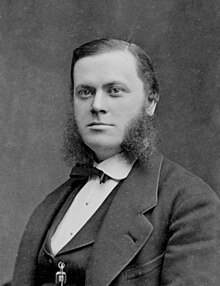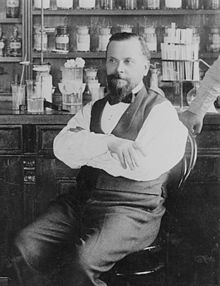Per Teodor Cleve
Per Teodor Cleve | |
|---|---|
 Per Teodor Cleve, c. 1880–1890 | |
| Born | 10 February 1840 Stockholm, Sweden |
| Died | 18 June 1905 (aged 65) Uppsala, Sweden |
| Nationality | Swedish |
| Alma mater | Stockholms Lyceum (1858) Uppsala University (1863) |
| Known for | discovery of holmium and thulium |
| Spouse | |
| Children | Astrid Cleve Agnes Cleve-Jonand Célie Brunius |
| Awards | Davy Medal (1894) |
| Scientific career | |
| Fields | Chemistry, geology |
Per Teodor Cleve (10 February 1840 – 18 June 1905) was a Swedish
Born in Stockholm in 1840, Cleve earned his
In 1879 Cleve discovered holmium and thulium.[3] His other contributions to chemistry include the discovery of aminonaphthalenesulfonic acids, also known as Cleve's acids. From 1890 on he focused on biological studies. He developed a method of determining the age and order of late glacial and postglacial deposits from the types of diatom fossils in the deposits, and wrote a seminal text in the field of oceanography. He died in 1905 at age 65.
Early life

Cleve was born in Stockholm, Sweden, as the thirteenth child of his father,[1][4] a merchant known as Fredrik Theodor Cleve.[4][5] Cleve's ancestors on his father's side came from western Germany and settled in Sweden in the late 18th century.[5]
Cleve showed interest in
Career
In 1860, aged 20, Cleve became
Cleve's first work was Några ammoniakaliska chromföreningar (Some compounds of ammonia and chromium, 1861).[2][6] He also wrote several more papers on complex compounds, including the compounds of platinum.[2][6] Additionally, Cleve synthesized several hundred complex platinum compounds.[6]
Cleve visited a number of laboratories in England, France, Italy, and Switzerland in the 1860s.

Cleve worked on the synthesis of complex chemical compounds until 1872.
Cleve discovered six forms of
Cleve, in collaboration with Otto Höglund prepared numerous previously-undiscovered salts of yttrium and erbium. The two also did work on the chemistry of the chemical elements thorium and lanthanum. By 1874, Cleve discovered that thorium was a quadrivalent element and also determined lanthanum to be trivalent. These findings were initially doubted by the scientific community.[5]
Cleve was the first observer of isomerism in platinumamine derivatives.[7]
Additionally, Cleve created a method of dating glacial and post-glacial deposits in the
Cleve's PhD
Cleve also studied hydrography and geology.[4]
Personal life, family, and death
In 1874, Cleve married
Per Teodore Cleve was a supporter of
Cleve began experiencing pleurisy in December 1904 and it affected his heart. He thought that he had recovered by the spring of 1905, and he returned home to Uppsala, Sweden,.[5] but he died there on 18 June 1905.[1]
Awards and legacy
Cleve joined the Royal Swedish Academy of Sciences in 1871. He received a Davy Medal in 1894 and 1904.[4][7]
The mineral cleveite is named for Cleve.[4]
References
- ^ a b c d e f g h i "Per Teodor Cleve". Encyclopædia Britannica. Retrieved 13 March 2014.
- ^ a b c d e f g Charles Scribner's Sons (2008), "Cleve, Per Teodor", encyclopedia.com, archived from the original on 15 March 2014, retrieved 13 March 2014
- ^ a b c Marshall, James L. Marshall; Marshall, Virginia R. Marshall (2015). "Rediscovery of the elements: The Rare Earths–The Confusing Years" (PDF). The Hexagon: 72–77. Retrieved 30 December 2019.
- ^ a b c d e f g h i j k l m n Per Theodor Cleve, retrieved 13 March 2014
- ^ a b c d e f g Chemical Society (Great Britain), Sir Humphry Davy, Bureau of Chemical Abstracts (Great Britain) (21 June 1906), The collected works of Sir Humphry Davy ...: Discourses delivered before the Royal society. Elements of agricultural chemistry, pt. I, Smith, Elder and Company
{{citation}}: CS1 maint: multiple names: authors list (link) - ^ a b c d e f g Ole Bostrup (2004), "Cleve, Per Theodor", encyclopedia.com, archived from the original on 15 March 2014, retrieved 14 March 2014
- ^ a b c Ira Remsen; Charles August Rouillu, eds. (1905), American Chemical Journal, Volume 34
- ^ a b Doug Stewart, "Holmium Element Facts / Chemistry", chemicool.com, retrieved 14 March 2014
- ^ Bradley Brooks, "Introduction to Holmium", Penetanguishene Secondary School, archived from the original on 15 March 2014, retrieved 14 March 2014
- ISBN 978-0199605637
- ISBN 978-0199605637
- ^ Marshall, James L.; Marshall, Virginia R. (2012). "Rediscovery of the Elements: Helium" (PDF). The Hexagon (Spring): 20–29. Retrieved 30 December 2019.
- ^ Weeks, Mary Elvira (1956). The discovery of the elements (6th ed.). Easton, PA: Journal of Chemical Education.
- ISBN 9783642020889
- ISBN 0810849798
